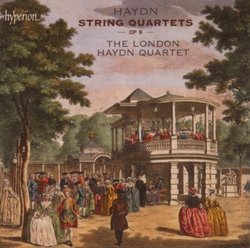| All Artists: Franz Joseph Haydn Title: Haydn: String Quartets, Op. 9 Members Wishing: 0 Total Copies: 0 Label: Hyperion UK Original Release Date: 1/1/2007 Re-Release Date: 11/13/2007 Album Type: Import Genre: Classical Styles: Chamber Music, Historical Periods, Classical (c.1770-1830) Number of Discs: 2 SwapaCD Credits: 2 UPC: 034571176116 |
Search - Franz Joseph Haydn :: Haydn: String Quartets, Op. 9
 | Franz Joseph Haydn Haydn: String Quartets, Op. 9 Genre: Classical
|
Larger Image |
CD Details |
CD ReviewsHaydn quartets on original instruments Mike Birman | Brooklyn, New York USA | 11/28/2007 (5 out of 5 stars) "Haydn composed his op.9 quartets in 1769. In them, you can still hear the impact of the empfindsamer stil, literally the 'sensitive style' that characterized that strange, brief Romantic flurry found in the 1760s and 1770s. Dynamic extremes, an almost jerky stop-and-go melodic technique, wide variations in mood and contrasts in instrumental color, are all aspects of the empfindsamer stil, which continued to percolate softly in the background before exploding forth in the 19th century as full-blown Romanticism. Wilhelm Friedemann and C.P.E. Bach were two famous composers in the empfindsamer stil. Sturm und drang is another stylistic aspect to these quartets, although to a much lesser degree. Haydn had composed two sets of Divertimenti a quattro, his op.1 and op.2, composed in the late 1750s, each with 5 movements and a light, breezy style designed for summer parties on the estate of his early patron, Baron Furnberg. Haydn did not consider them true quartets, and always pointed to his op.9 series as the first true string quartets.
There is a greater sense of seriousness in the op.9 quartets, more complexity in their part writing with the first indications of Haydn's later contrapuntal mastery. The dialog between violins, viola and cello are still somewhat rudimentary but their rhetoric and thematic development are a quantum leap over the earlier op.1 and op.2. The op.9 set are the string quartets that first caught Mozart's ear and revealed the possibilities of the form to the already venerable 13 year old composer. Hopefully, these superb performances represent the inaugural efforts of a complete traversal of Haydn's masterful string quartets from The London Haydn Quartet, a young group who play on original instruments. Their stylistically sophisticated performances represent the latest scholarship. They have chosen to use an early printing of the op.9 quartets: a London edition (Longman and Broderip) from 1790, since the early printings preserve all of the anomalies that later ones iron out. Matters of articulation, dynamics, even notes or rhythms become matters of choice for the performers. Removing the smooth consistency of a modern edition creates a world of musical performance where spontaneous choices must be made according to taste, experience and understanding of musical language, much as it would have been in the 18th Century. The result is a freshness of interpretation that is almost as if the music is being played for the first time. These are splendid performances, beautifully recorded in Hyperion's usual deep, rich, clear sound. Haydn's quartets are one of the glories of music. Here are the first jewels in the crown. Strongly recommended. Mike Birman" |

 Track Listings (12) - Disc #1
Track Listings (12) - Disc #1